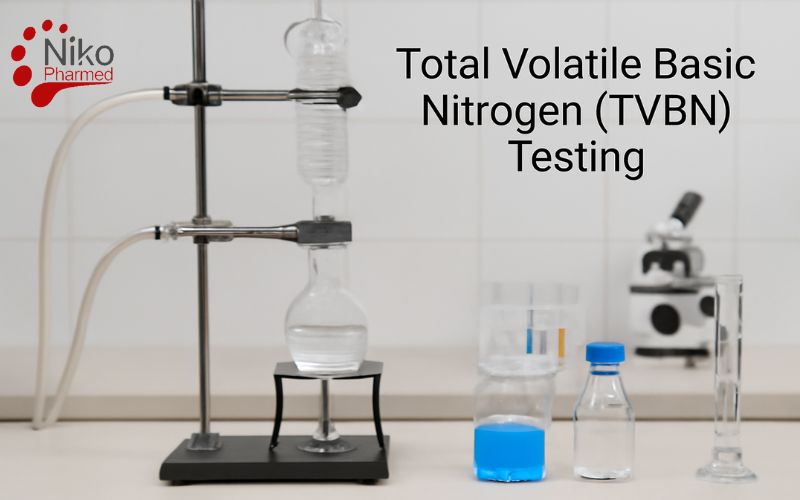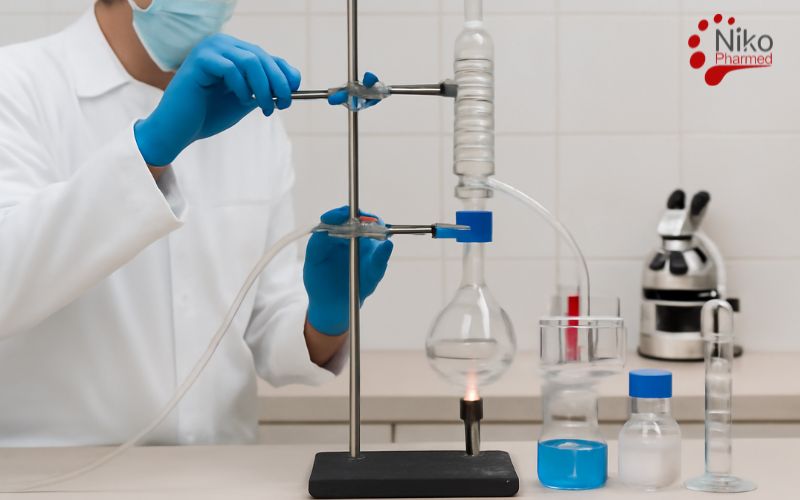What is Total Volatile Basic Nitrogen (TVBN) Testing?
Total Volatile Basic Nitrogen (TVBN) testing is an analytical method used to quantify the concentration of volatile nitrogenous bases—primarily ammonia (NH₃), trimethylamine (TMA), and dimethylamine (DMA)—that are released during the microbial decomposition and enzymatic degradation of proteins in fish, meat, and other proteinaceous foods.
TVBN is considered a reliable chemical spoilage index, as the accumulation of these basic compounds correlates with microbial activity and the progressive deterioration of product quality. The test typically involves alkaline distillation of homogenized samples, trapping of the volatile bases in an acid solution (e.g., boric acid), followed by titration or spectrophotometric quantification.
Results are expressed in milligrams of nitrogen per 100 grams of sample (mg N/100 g), and regulatory agencies establish threshold values (e.g., ≤25 mg N/100 g for fresh fish) to determine freshness, shelf-life, and consumer safety. This makes TVBN a critical parameter in food quality control, safety assurance, and regulatory compliance within the seafood and meat industries. In routine seafood and meat quality control, Total Volatile Basic Nitrogen measurements are often interpreted together with Moisture Content Analysis and Protein Analysis to differentiate natural protein variability from spoilage-related nitrogen formation.
The aim of the Total Volatile Basic Nitrogen (TVBN) test is to assess the degree of protein degradation and microbial spoilage in protein-rich foods (especially fish, seafood, and meat products) by measuring the accumulation of volatile nitrogenous compounds such as ammonia, trimethylamine, and dimethylamine.
In simpler terms, the purpose is to:
- Evaluate freshness and quality of raw or processed proteinaceous foods.
- Detect early stages of spoilage, even before obvious sensory changes (odor, texture) occur.
- Provide an objective chemical index that correlates with microbial growth and enzymatic breakdown of proteins.
- Ensure food safety and regulatory compliance, since exceeding established TVBN limits indicates that the product is no longer safe or suitable for consumption.
Procedure for TVBN Testing
Sample Preparation
Homogenize 10–20 g of finely minced fish, seafood, or meat in distilled water (often 90–100 mL).
Adjust the slurry with magnesium oxide (MgO) or sodium hydroxide (NaOH) to make the medium alkaline.
Purpose: convert volatile nitrogenous bases (ammonia, TMA, DMA) into gaseous forms.
Alkaline Distillation
Place the homogenized sample in a Kjeldahl distillation apparatus or similar distillation setup.
Steam distillation is carried out for 15–30 minutes, during which volatile bases are liberated.
The distillate is captured in a flask containing boric acid solution (2–4%), often with mixed indicator dyes (e.g., methyl red + bromocresol green).
Purpose: absorb the basic volatiles and convert them into stable ammonium salts.
Titration
The boric acid solution (now containing absorbed volatile bases) is titrated with standardized hydrochloric acid (HCl, 0.01 N) or sulfuric acid.
The endpoint is indicated by a color change in the mixed indicator (usually from green to pink).
A blank test (with no sample) must also be performed for accuracy.
(Where spectrophotometric endpoints are used instead of visual titration, absorbance is measured on calibrated Ultraviolet–Visible Spectroscopic (UV–Vis) instruments at method-specific wavelengths)
Calculation
The TVBN content is expressed as:
TVBN(mgN/100g)=(Vs−Vb)×N×14×100/W
Where:
- VsV_s = volume of titrant used for sample (mL)
- VbV_b = volume of titrant used for blank (mL)
- NN = normality of acid (mol/L)
- 1414 = molecular weight of nitrogen (mg/mmol)
- WW = weight of sample (g)
Interpretation of Results
- ≤ 25 mg N/100 g → Fresh fish/meat
- 25–35 mg N/100 g → Borderline quality
- > 35 mg N/100 g → Spoiled, unfit for human consumption
(Values may vary depending on product type and regional standards, e.g., EU allows up to 35 mg N/100 g for certain fish species).
Permissible TVN/TVBN Limits in Protein Foods
| Product Type | Acceptable Limit (mg N / 100 g sample) | Notes |
|---|---|---|
| Fresh Fish (general) | ≤ 25 | Above 25 → loss of freshness, spoilage begins |
| Marine Fish (EU regulation) | ≤ 35 | Some species (e.g., cod, hake) may allow up to 35 |
| Shellfish / Crustaceans | ≤ 30 | Higher protein degradation rate |
| Frozen Fish | ≤ 30 | Freezing slows spoilage, so slightly higher accepted |
| Salted / Smoked Fish | ≤ 35 | Processing influences baseline TVN |
| Canned Fish (e.g., tuna, sardine, mackerel) | ≤ 50–60 | Depending on Codex and national standards |
| Red Meat (beef, lamb) | ≤ 20 | Higher values indicate microbial spoilage |
| Poultry (chicken, turkey) | ≤ 25 | Reflects higher susceptibility to microbial breakdown |
| Processed Meat Products (sausages, cured meat) | ≤ 30–40 | Range varies with formulation and preservatives |
Key Points
- TVN is product- and region-specific → some species have higher natural baseline levels of volatile amines.
- EU Regulation (EC No 2074/2005): sets maximum TVBN limits for certain fish families (e.g., Gadoidae ≤ 35 mg/100 g).
- Codex Alimentarius: recommends limits consistent with 25–35 mg/100 g for fresh fish.
- Exceeding limits = product considered spoiled and unfit for human consumption.
In summary
Fresh fish/meat: ≤ 20–25 mg/100 g
Frozen/processed fish: up to 30–35 mg/100 g
Canned fish: ≤ 50–60 mg/100 g
In seafood HACCP plans and shelf-life studies, TVBN limits are frequently evaluated alongside Moisture Content Analysis, Salt Content Testing and pH Testing to define acceptance criteria, optimise storage conditions and validate processing steps for fish, seafood and meat products
Nikopharmed TVBN Testing Laboratory
Laboratory Accreditation and Global Recognition
At Nikopharmed, our TVBN Testing Services are backed by ISO/IEC 17025 certification and ILAC accreditation, ensuring the highest levels of technical competence and analytical quality. These global recognitions guarantee that our determination of volatile nitrogen compounds—critical indicators of protein degradation and microbial spoilage—fully complies with international standards and regulatory frameworks, including AOAC International, ISO methods, Codex Alimentarius, USP, and the European Pharmacopoeia. Our results are accepted worldwide by regulatory authorities overseeing food, seafood, meat, water, nutraceutical, and pharmaceutical products.
Technical Excellence and Validated Infrastructure
Our advanced analytical facility is equipped with precision instrumentation for alkaline distillation, volatile nitrogen capture, and titrimetric/spectrophotometric quantification.
We maintain validated distillation units, automated sample handling systems, and precision analytical balances, ensuring robust and reproducible determination of TVBN levels. This infrastructure allows us to analyze fresh and processed fish, seafood, red meat, poultry, dairy products, nutraceuticals, and protein-based formulations with the highest accuracy and sensitivity.
Regulatory-Ready Reporting and Timely Results
In industries where product freshness, quality assurance, and regulatory compliance are critical, Nikopharmed provides rapid, reliable, and defensible TVBN test results.
Our optimized workflows deliver fast turnaround times while maintaining uncompromised analytical precision—supporting:
- Shelf-life studies
- Export/import inspections
- Label claim verification
- Regulatory submissions
- Quality assurance and safety monitoring
Confidentiality and Data Integrity
We guarantee complete confidentiality and data security in all analyses. Every TVBN test is conducted under strict non-disclosure agreements and supported by 21 CFR Part 11-compliant electronic data systems. Each analysis includes a comprehensive audit trail ensuring traceability, reliability, and integrity of results. Proprietary research data, formulations, and regulatory submissions are safeguarded under the highest professional and ethical standards.
Competitive Pricing with Uncompromised Quality
Nikopharmed offers cost-effective TVBN testing solutions tailored for small enterprises, multinational corporations, and regulatory authorities. Our transparent pricing structure allows clients to maintain compliance efficiently, reduce approval timelines, and ensure global acceptance—without compromising on data quality or credibility.
To request testing or a complimentary consultation contact Nikopharmad
Partner with Nikopharmed for Expert TVBN Testing
By partnering with Nikopharmed, you gain access to a globally accredited laboratory specializing in Total Volatile Basic Nitrogen testing. Whether ensuring the freshness of fish and meat, verifying compliance with Codex or EU regulations, or supporting food safety, export certifications, and shelf-life validation, our expertise delivers accurate, reliable, and internationally recognized results—helping you achieve compliance with confidence.


